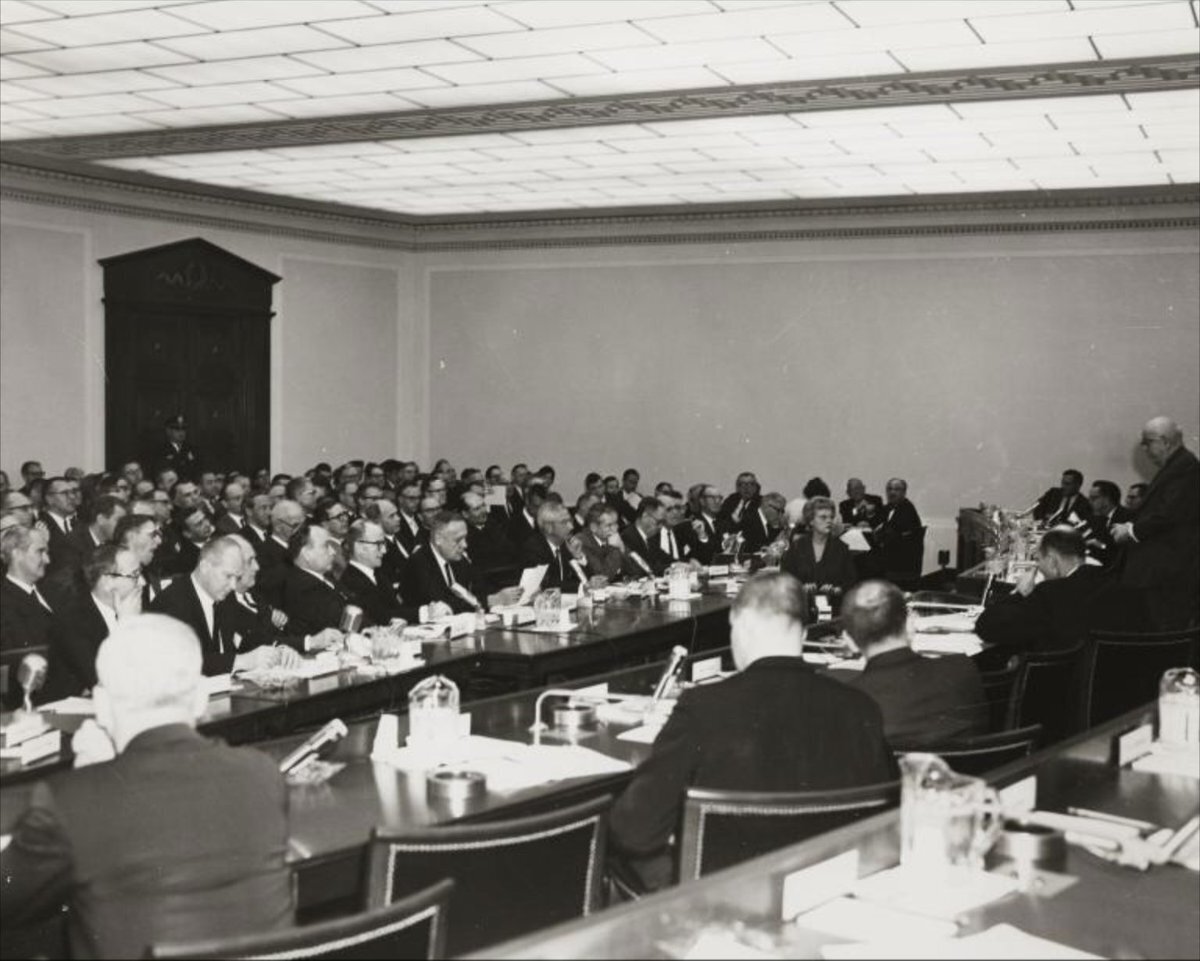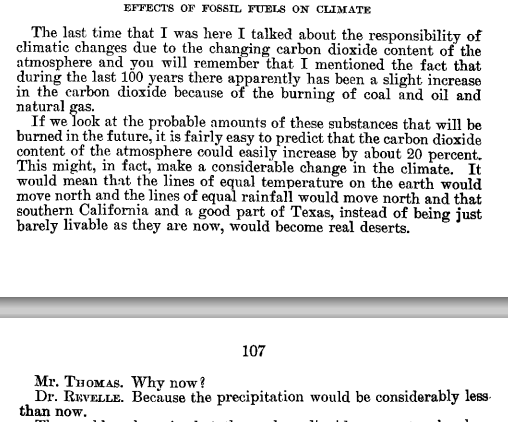
Dr. Roger Revelle (seated, far right) testifies before Congress, May 1,
1957. ([Roger Revelle papers,
UCSD](https://library.ucsd.edu/dc/object/bb3891866w))
Unprecedented heat and wildfires driven by fossil-fueled global warming
are ravaging the forests of California and the Pacific Northwest – in
line with scientific predictions to the U.S. Congress from the 1950s.
Over sixty-three years ago, physical oceanographer Roger Revelle
testified to Congress that fossil-fueled climate change could turn
southern California and most of Texas into “real deserts.”
On May 1, 1957, Dr. Revelle testified at the hearing on appropriations
for the International Geophysical Year, Independent Offices
Subcommittee, House Committee on Appropriations:
The last time that I was here I talked about the responsibility of
climatic changes due to the changing carbon dioxide content of the
atmosphere and you will remember that I mentioned the fact that during
the last 100 years there apparently has been a slight increase in
the carbon dioxide because of the burning of coal and oil and natural
gas.
If we look at the probable amounts of these substances that will be
burned in the future, it is fairly easy to predict that the carbon
dioxide content of the atmosphere could easily increase by about 20
percent. This might, in fact, make a considerable change in the
climate. It would mean that the lines of equal temperature on the
earth would move north and the lines of equal rainfall would move
north and that southern California and a good part of Texas, instead
of being just barely livable as they are now, would become real
deserts.
Atmospheric carbon dioxide concentrations in 1957 were 315 parts per
million. It reached 378 ppm, Revelle’s cautioned 20 percent
increase,
in 2004.
In 2015, California Gov. Jerry Brown announced the state’s first-ever
mandatory water use
restrictions.
As of September 2020, the planet is now at 410
ppm, a 30 percent increase.
Revelle’s testimony in the previous year in support of federal funding
to monitor atmospheric and oceanic carbon dioxide levels was the first
time that manmade global warming was discussed in the Congressional
record.
“We are making perhaps the greatest geophysical experiment in
history,”
he said on March 8, 1956, “an experiment which could not be made in the
past because we didn’t have an industrial civilization and which will be
impossible to make in the future because all the fossil fuels will be
gone.”
Revelle also noted that regional shifts in climate in the past led to
“the rise and fall and complete decay of many civilizations.”
In response to questions from Rep. Sydney Yates (D-Ill.) and Rep. Albert
Thomas (D-Texas), Dr. Revelle elucidated further:
People talk about making fresh water out of sea water. God does that
for them far better than any man ever could. He evaporates three feet
of water on every square foot of the ocean every year. The problem is
that the distribution system is bad. The water coming from the ocean
moves over the land but mostly over the northern and southern parts of
the land, and this circulation pattern, or transport of water vapor
from the sea to the land and the precipitation on the land, apparently
shifts with the temperature; at least we think it does, and there
seems to be a broad belt called the horse latitudes between the
equatorial regions and the belt of cyclonic storms where the
precipitation is minimal.
If you increase the temperature of the earth, the north latitude belt,
which covers most of the western part of the United States and the
Southwest, would move to the north.
“Only God knows whether what I am saying is true or not,” Revelle
concluded. But his understanding of the science of fossil-fueled global
warming has now been proven correct. The climate of southern California
has undergone a phase shift to a persistently hotter, drier regime — a
permanent shift if action is not taken to end the burning of fossil
fuels and reduce the concentration of industrial greenhouse pollution in
the atmosphere.

Transcript of Revelle’s testimony, under the heading “EFFECTS
OF FOSSIL FUELS ON CLIMATE”
 Dr. Roger Revelle (seated, far right) testifies before Congress, May 1,
1957. ([Roger Revelle papers,
Dr. Roger Revelle (seated, far right) testifies before Congress, May 1,
1957. ([Roger Revelle papers,
